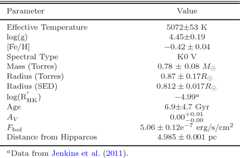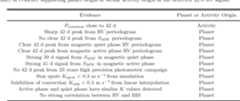DOI:10.1093/mnras/sty1933 - Corpus ID: 54871108
The first super-Earth detection from the high cadence and high radial velocity precision Dharma Planet Survey
@article{Ma2018TheFS, title={The first super-Earth detection from the high cadence and high radial velocity precision Dharma Planet Survey}, author={Bo Ma and Jian Ge and Matthew W. Muterspaugh and Michael A. Singer and Gregory W. Henry and Jonay I Gonz{\'a}lez Hern{\'a}ndez and Sirinrat Sithajan and Sarik Jeram and Michael W. Williamson and Keivan G. Stassun and Benjamin Kimock and Frank V{\'a}rosi and Sidney Schofield and Jian Liu and Scott Powell and Anthony Cassette and Hali L. Jakeman and Louis Avner and Nolan Grieves and Rory Barnes and Bo Zhao and Sankalp Gilda and Jim Grantham and G. Stafford and David Savage and Steve Bland and Brent Ealey}, journal={Monthly Notices of the Royal Astronomical Society}, year={2018}, url={https://api.semanticscholar.org/CorpusID:54871108}}- B. MaJ. GeBrent Ealey
- Published inMonthly notices of the Royal…18 July 2018
- Physics
The Dharma Planet Survey (DPS) aims to monitor about 150 nearby very bright FGKM dwarfs (within 50 pc) during 2016$-$2020 for low-mass planet detection and characterization using the TOU very high resolution optical spectrograph (R$\approx$100,000, 380-900nm). TOU was initially mounted to the 2-m Automatic Spectroscopic Telescope at Fairborn Observatory in 2013-2015 to conduct a pilot survey, then moved to the dedicated 50-inch automatic telescope on Mt. Lemmon in 2016 to launch the survey…
Figures and Tables from this paper
23 Citations
The NEID Earth Twin Survey. III. Survey Performance after Three Years on Sky
- Arvind F. GuptaEvan FitzmauriceR. Terrien
- 2025
Physics
The NEID Earth Twin Survey (NETS) has been delivering a rich set of precise radial velocity (RV) measurements for 41 bright, nearby main-sequence stars. Here, we describe the status of the survey…
Combining high-contrast imaging and radial velocities to constrain the planetary architectures of nearby stars
Context. Nearby stars are prime targets for exoplanet searches and characterization using a variety of detection techniques. Combining constraints from the complementary detection methods of…
The Micro-arcsecond Astrometry Small Satellite: MASS
In the search for exoplanets, one of the most sought-after goals from the outset has been to survey nearby systems for Earth-mass planets in their habitable zones. Because of their relatively low…
Data Reduction Pipeline of the TOU Optical Very High Resolution Spectrograph and Its sub-m s−1 Performance
TOU is an extremely high resolution optical spectrograph (R=$100,000$, 380-900~nm), which is designed to detect low mass exoplanets using the radial velocity technique.We describe an IDL-based radial…
Doppler Constraints on Planetary Companions to Nearby Sun-like Stars: An Archival Radial Velocity Survey of Southern Targets for Proposed NASA Direct Imaging Missions
- K. LaliotisJ. BurtR. Wittenmyer
- 2023
Physics
Directly imaging temperate rocky planets orbiting nearby, Sun-like stars with a 6 m class IR/O/UV space telescope, recently dubbed the Habitable Worlds Observatory, is a high-priority goal of the…
The California Legacy Survey. I. A Catalog of 178 Planets from Precision Radial Velocity Monitoring of 719 Nearby Stars over Three Decades
- L. RosenthalB. FultonJ. Wright
- 2021
Physics
We present a high-precision radial velocity (RV) survey of 719 FGKM stars, which host 164 known exoplanets and 14 newly discovered or revised exoplanets and substellar companions. This catalog…
Transiting planet candidate from K2 with the longest period
Context. We present the transit and follow-up of a single transit event from Campaign 14 of K2, EPIC248847494b, which has a duration of 54 h and a 0.18% depth. Aims. Using photometric tools and…
Dynamical Viability Assessment for Habitable Worlds Observatory Targets
Exoplanetary science is increasingly prioritizing efforts toward direct imaging of planetary systems, with emphasis on those that may enable the detection and characterization of potentially…
The Initial Mass Function Based on the Full-sky 20 pc Census of ∼3600 Stars and Brown Dwarfs
- J. KirkpatrickF. MaroccoDavid Zurek
- 2024
Physics
A complete accounting of nearby objects—from the highest-mass white dwarf progenitors down to low-mass brown dwarfs—is now possible, thanks to an almost complete set of trigonometric parallax…
The EXPRES Stellar Signals Project II. State of the Field in Disentangling Photospheric Velocities
- Lily L. ZhaoD. FischerA. Szymkowiak
- 2022
Physics
Measured spectral shifts due to intrinsic stellar variability (e.g., pulsations, granulation) and activity (e.g., spots, plages) are the largest source of error for extreme-precision radial-velocity…
97 References
A robotic, compact, and extremely high resolution optical spectrograph for a close-in super-Earth survey
- J. GeS. PowellJ. E. Maxwell
- 2014
Physics, Engineering
One of the most astonishing results from the HARPS and Kepler planet surveys is the recent discovery of close-in super-Earths orbiting more than half of FGKM dwarfs. This new population of exoplanets…
On-sky Doppler performance of TOU optical very high-resolution spectrograph for detecting low-mass planets
The TOU robotic, compact very high resolution optical spectrograph (R=100,000, 0.38-0.9 microns) has been fully characterized at the 2 meter Automatic Spectroscopy Telescope (AST) at Fairborn…
A SUPER-EARTH ORBITING THE NEARBY SUN-LIKE STAR HD 1461
We present precision radial velocity (RV) data that reveal a Super-Earth mass planet and two probable additional planets orbiting the bright nearby G0V star HD 1461. Our 12.8 years of Keck High…
THE CALIFORNIA PLANET SURVEY. I. FOUR NEW GIANT EXOPLANETS
We present precise Doppler measurements of four stars obtained during the past decade at Keck Observatory by the California Planet Survey (CPS). These stars, namely, HD 34445, HD 126614, HD 13931,…
SIX PLANETS ORBITING HD 219134
- S. VogtJ. BurtG. Laughlin
- 2015
Physics
We present new, high-precision Doppler radial velocity (RV) data sets for the nearby K3V star HD 219134. The data include 175 velocities obtained with the HIRES Spectrograph at the Keck I Telescope…
No planet for HD 166435
The G0 V star HD 166435 has been observed by the ber-fed spectrograph ELODIE as one of the targets in the large extra-solar planet survey that we are conducting at the Observatory of Haute-Provence.…
The HARPS search for Earth-like planets in the habitable zone - I. Very low-mass planets around HD 20794, HD 85512, and HD 192310
Context. In 2009 we started an intense radial-velocity monitoring of a few nearby, slowly-rotating and quiet solar-type stars within the dedicated HARPS-Upgrade GTO program. Aims. The goal of this…
Design and performance of a new generation, compact, low cost, very high Doppler precision and resolution optical spectrograph
This paper is to report the design and performance of a very high Doppler precision cross-dispersed echelle spectrograph, EXtremely high Precision ExtrasolaR planet Tracker III (EXPERT-III), as part…
The HARPS search for southern extra-solar planets
- J. DelisleD. SégransanA. Wyttenbach
- 2018
Physics
We report the discovery of four super-Earth planets around HD 215152, with orbital periods of 5.76, 7.28, 10.86, and 25.2 d, and minimum masses of 1.8, 1.7, 2.8, and 2.9 M⊕ respectively. This…
The HARPS search for southern extra-solar planets - XXXI. The M-dwarf sample
- X. BonfilsX. DelfosseJ. Bertaux
- 2011
Physics
Searching for planets around stars with different masses helps us to assess the outcome of planetary formation for different initial conditions. The low-mass M dwarfs are also the most frequent stars…
...
Related Papers
Showing 1 through 3 of 0 Related Papers




















